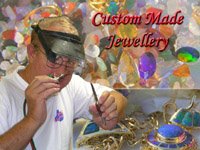How is Opal mined?
Let’s start by talking about how opal was mined in the late nineteenth century when it all began in Australia.
As opal is not found on the surface, or very rarely, the miner had to dig underground. Opal is found in what is called “opal dirt.” This opal dirt is mostly found under a layer of very hard sandstone.
The first miners simply used picks and shovels. They dug a hole big enough to crawl into and then they kept digging this down until they reached the opal dirt. This hole was called the mine shaft. This could be anywhere from a few metres to twenty metres or more.
Once the level had been found then they would dig horizontally in layers big enough to crawl through. These were called “drives.”
The spoil, or useless material, had to be taken out of the mine so that the miner could move around. So they set up what was called a windlass. This allowed the miner or someone at the top of the mine to turn a handle and bring a bucket to the surface.
For light the miner often simply used a candle. Well, as you can imagine a miner working alone would not get very much done in a day.
What happens today is often not too far removed from those early days. Some hobby miners still use picks and shovels as well as small jackhammers. They use a hoist which takes the bucket of spoil to the surface. A lone miner still cannot do a great deal in a day by himself. It is hard physical work and if a miner works month after month he might not find a single piece of opal worth selling.
The next level of mining is the serious miner. He uses a diesel powered digging machine. Similar to the type of excavation machines used above ground only a bit more compact and specially made for the mining process. To remove the spoil from the mine he will have a machine called a “blower” which actually sucks the spoil up through a pipe to the top of the mine and deposits it into a tip truck which then takes it to a dump site.
This kind of set up will cost $100,000 or more. This is generally used by the serious full time miner hoping to make a living from opal mining.
Then there is the very serious opal miner who uses heavy earth moving machinery such as you find on a construction site and carries out what is called “open cut” mining. This is where a total mine lease of fifty square metres and perhaps twenty metres deep is removed, checked for opal deposits, and then filled back in and rehabilitated.
Why is opal not mined on a huge scale like coal mining is? The answer is because opal is hard to find and almost impossible to predict where it will be found. Entire open cut mining ventures may turn up not a single opal and conversely the lone miner with a pick and shovel might find a million dollars worth in a single morning’s work.
To sink large sums of money in such a haphazard and risky venture is not considered a worthwhile investment for shareholders’ funds so opal mining is left to the adventurous seekers of fortunes who are willing to risk a lot and work hard. Something to think about when admiring your lovely opal jewelry.
